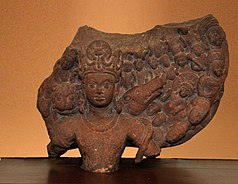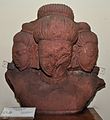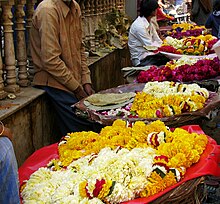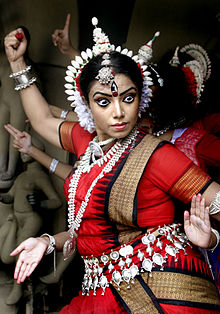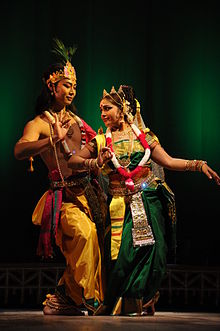
Balarama is a Hindu god, and the elder brother of Vāsudeva-Krishna He is particularly significant in the Jagannath tradition, as one of the triad deities. He is also known as Haladhara, Halayudha, Baladeva, Balabhadra, and Sankarshana.

Avatar is a concept within Hinduism that in Sanskrit literally means 'descent'. It signifies the material appearance or incarnation of a powerful deity, or spirit on Earth. The relative verb to "alight, to make one's appearance" is sometimes used to refer to any guru or revered human being.

Vāsudeva I was a Kushan emperor, last of the "Great Kushans." Named inscriptions dating from year 64 to 98 of Kanishka's era suggest his reign extended from at least 191 to 232 CE. He ruled in Northern India and Central Asia, where he minted coins in the city of Balkh (Bactria). He probably had to deal with the rise of the Sasanians and the first incursions of the Kushano-Sasanians in the northwest of his territory.

The Bhagavata tradition, also called Bhagavatism, refers to an ancient religious sect that traced its origin to the region of Mathura. After its syncretism with the Brahmanical tradition of Vishnu, Bhagavatism became a pan-Indian tradition by the second century BCE, according to R.C. Majumdar.

Pancharatra was a religious movement in Hinduism that originated in late 3rd-century BCE around the ideas of Narayana and the various avatars of Vishnu as their central deities. The movement later merged with the ancient Bhagavata tradition and contributed to the development of Vaishnavism. The Pancharatra movement created numerous literary treatises in Sanskrit called the Pancharatra Samhitas, and these have been influential Agamic texts within the theistic Vaishnava movements.

Panchayatana puja also known as Pancha Devi Deva Puja is a system of puja (worship) in the Smarta sampradaya, which is one of four major sampradaya of Hinduism. It consists of the worship of five deities set in a quincunx pattern, the five deities being Ganesha, Adi Shakti, Shiva, Vishnu and Surya. Sometimes an Ishta Devata or Kartikeya is the sixth deity in the mandala.

Vaishnavism is one of the major Hindu denominations along with Shaivism, Shaktism, and Smartism. It is also called Vishnuism since it considers Vishnu as the sole supreme being leading all other Hindu deities, that is, Mahavishnu. Its followers are called Vaishnavites or Vaishnavas, and it includes sub-sects like Krishnaism and Ramaism, which consider Krishna and Rama as the supreme beings respectively. According to a 2010 estimate by Johnson and Grim, Vaishnavism is the largest Hindu sect, constituting about 641 million or 67.6% of Hindus.
Para-Vasudeva is a term found in the Vaishnavism tradition of Hinduism. It refers to the supreme and transcendental form of God, from which all of his manifestations emerge. The shakti of this form of God is regarded to contribute to the avataras, the material appearances of the deity on earth.

Vāsudeva, later incorporated as Vāsudeva-Krishna, Krishna-Vāsudeva or simply Krishna, was the son of Vasudeva Anakadundubhi, king of the Vrishnis in the region of Mathura. He was a leading member of the Vrishni heroes, and may well have been an historical ruler in the region of Mathura.

Vishnu, also known as Narayana and Hari, is one of the principal deities of Hinduism. He is the supreme being in Vaishnavism, one of the major traditions within contemporary Hinduism.

Ekanamsha is a Hindu goddess. She is primarily identified with the illusory power of Vishnu is Yogamaya.

Vaikuntha Chaturmurti or Vaikuntha Vishnu is a four-headed aspect of the Hindu god Vishnu, mostly found in Nepal and Kashmir. The icon represents Vishnu as the Supreme Being. He has a human head, a lion head, a boar head and a fierce head. Sometimes, even three-headed but aspects of Vishnu where the fierce rear head is dropped are considered to represent Vaikuntha Chaturmurti. Though iconographical treatises describe him to eight-armed, he is often depicted with four. Generally, Vaikuntha Chaturmurti is shown standing but sometimes he is depicted seated on his vahana (mount) Garuda.
Vyūha means - 'to arrange troops in a battle array (formation)', 'to arrange, put or place in order, to dispose, separate, divide, alter, transpose, disarrange, resolve '. Its root is व्यः which means - a 'cover' or 'veil'. This word also refers to emanation and to the manifest power of Lord Vishnu. It has different meanings depending on the doctrine of the treatise and the context, such as revealing of the knowledge of Vedas, manifestation of Vishnu or Buddha, and the war formations of Mahabharata.

The Art of Mathura refers to a particular school of Indian art, almost entirely surviving in the form of sculpture, starting in the 2nd century BCE, which centered on the city of Mathura, in central northern India, during a period in which Buddhism, Jainism together with Hinduism flourished in India. Mathura "was the first artistic center to produce devotional icons for all the three faiths", and the pre-eminent center of religious artistic expression in India at least until the Gupta period, and was influential throughout the sub-continent.

The Vishnu nicolo seal is a "finely engraved" oval agate seal from the Gandhara region, dated to the 4th century CE. Since 1892 it has been in the British Museum. Nicolo is an abbreviation of the Italian onicolo, meaning "little onyx", a type of stone, often made of different layers in various shades of blue, used for intagli.
The Vasu Doorjamb Inscription is an early 1st-century CE Sanskrit inscription in Brahmi script dedicated to the deity Vāsudeva, related to the Vaishnavism tradition of Hinduism. It is also one of the several dedicatory inscriptions from Mathura bearing the name of the Indo-Scythian Northern Satrap ruler Sodasa, which are useful as historic markers for the first half of the 1st century CE.

Kushan art, the art of the Kushan Empire in northern India, flourished between the 1st and the 4th century CE. It blended the traditions of the Greco-Buddhist art of Gandhara, influenced by Hellenistic artistic canons, and the more Indian art of Mathura. Kushan art follows the Hellenistic art of the Greco-Bactrian Kingdom as well as Indo-Greek art which had been flourishing between the 3rd century BCE and 1st century CE in Bactria and northwestern India, and the succeeding Indo-Scythian art. Before invading northern and central India and establishing themselves as a full-fledged empire, the Kushans had migrated from northwestern China and occupied for more than a century these Central Asian lands, where they are thought to have assimilated remnants of Greek populations, Greek culture, and Greek art, as well as the languages and scripts which they used in their coins and inscriptions: Greek and Bactrian, which they used together with the Indian Brahmi script.

The Vrishni heroes, also referred to as Pancha-viras, are a group of five legendary, deified heroes who are found in the literature and archaeological sites of ancient India. Their earliest worship is attestable in the clan of the Vrishnis near Mathura by 4th-century BCE. Legends are associated with these deified heroes, some of which may be based on real, historical heroes of the Vrishni clan. Their early worship has been variously described as cross-sectarian, much like the cult of the Yakshas, related to the early Bhagavata tradition of Hinduism, and with possible links to Jainism as well. They and their legends – particularly of Krishna and Balarama – have been an important part of the Vaishnava tradition of Hinduism.

Caturvyūha or Chatur-vyūha, is an ancient Indian religious concept initially focusing on the four earthly emanations (Vyūhas) of the Supreme deity Nārāyaṇa, and later Viṣṇu. The first of these emanations is the hero-god Vāsudeva, with the other emanations being his kinsmen presented as extensions of Vāsudeva himself. From around the 1st century CE, this "Vyuha doctrine" (Vyūhavāda) developed out of the earlier Vīravāda cult of the Vrishni heroes, in which the five heroes Saṃkarṣaṇa, Vāsudeva, Pradyumna, Samba and Aniruddha had remained mostly human in character. Still later, around the 4th century CE, it evolved into the Avatāravāda system of incarnations of Vishnu, in which Vishnu was the primordial being and the Vrishni heroes had become his avatars.
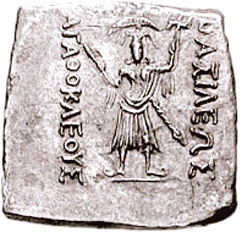
Saṃkarṣaṇa later known as Balarama, was a son of Vasudeva Anakadundubhi, king of the Vrishnis in the region of Mathura. He was a leading member of the Vrishni heroes, and may well have been an ancient historical ruler in the region of Mathura. The cult of Saṃkarṣaṇa with that of Vāsudeva is historically one of the earliest forms of personal deity worship in India, attested from around the 4th century BCE.

















